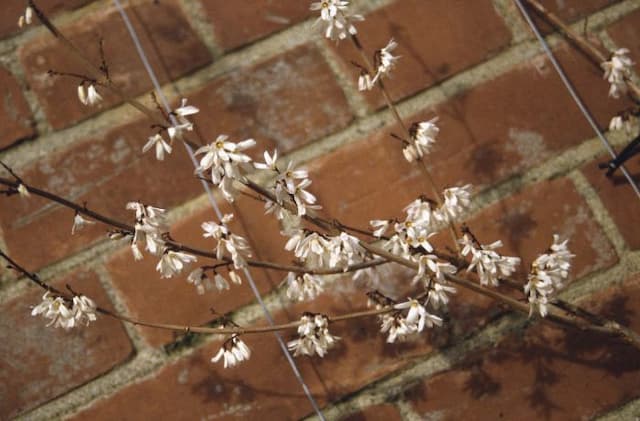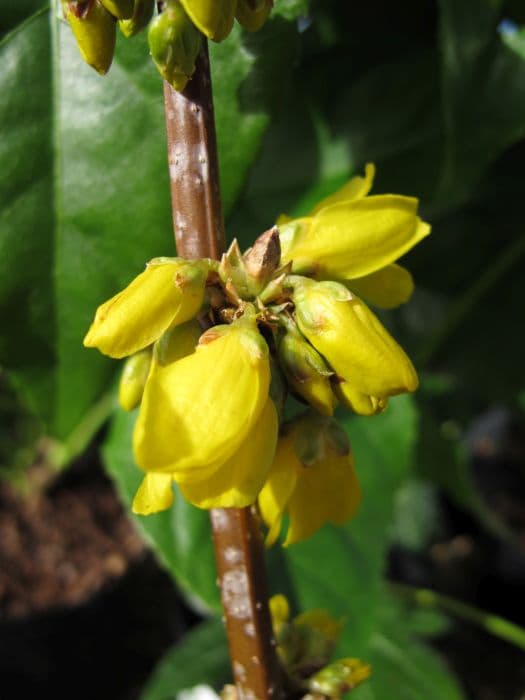Dwarf Korean Lilac Syringa meyeri Flowerfesta White = 'Anny200810' (PBR) (Flowerfesta Series)

ABOUT
The Syringa meyeri Flowerfesta White, part of the Flowerfesta Series, boasts an attractive appearance with its showy, pristine white flowers. This plant, commonly known as the Meyer lilac, features clusters of delicate blossoms that exude a sweet fragrance, reminiscent of the classic lilac scent that is often associated with springtime. Each individual flower is small, yet the bunches create a full, luxurious look as they cover the branches. The blooms contrast beautifully against the plant's fresh green foliage, which provides a lush backdrop for the floral display. Emerging in spring, the leaves are pointed and heart-shaped, adding to the overall aesthetics of the Meyer lilac. The foliage remains healthy and vigorous throughout the growing season, offering a continuous sense of vitality to any garden space. When not in bloom, the greenery of the Meyer lilac still holds interest due to its dense, rounded growth habit, which imparts a sense of structure and formality. During the flowering period, the plant becomes a focal point in landscapes with its bright white blossoms that attract pollinators like butterflies and bees. When massed together with others from the Flowerfesta Series, it can create an eye-catching display of elegance and charm, perfect for a variety of garden settings. The Meyer lilac is appreciated not only for its aesthetics but also for its ability to bring a refreshing and serene energy to its surroundings.
About this plant
 Names
NamesFamily
Oleaceae
Synonyms
Meyer Lilac, Korean Dwarf Lilac, Flowerfesta White Lilac
Common names
Syringa meyeri Flowerfesta White = 'Anny200810'
 Toxicity
ToxicityTo humans
The Syringa meyeri, commonly known as Meyer lilac, is not considered highly toxic to humans. However, as with many plants, ingesting large quantities of any part, including leaves, stems, and flowers, could cause mild stomach upset. Symptoms might include nausea, vomiting, and diarrhea. It is always wise to avoid eating parts of ornamental plants due to potential individual sensitivities or unknown toxicity.
To pets
The Meyer lilac (Syringa meyeri) is generally recognized as safe for pets, including cats and dogs. There is no widespread evidence to suggest that the Meyer lilac possesses significant toxicity to pets. That said, ingestion of plant material can potentially lead to mild gastrointestinal upset in some animals, which may manifest as vomiting or diarrhea. It is still advisable to prevent pets from ingesting the plant to avoid any possible discomfort.
 Characteristics
CharacteristicsLife cycle
Perennials
Foliage type
Deciduous
Color of leaves
Green
Flower color
White
Height
4-5 feet (1.2-1.5 meters)
Spread
5-6 feet (1.5-1.8 meters)
Plant type
Shrub
Hardiness zones
4-7
Native area
China
Benefits
 General Benefits
General Benefits- Compact Growth Habit - Suitable for smaller gardens or limited space, as it maintains a neat and tidy form.
- Attractive Flowers - Produces white, fragrant blossoms that add beauty and interest to the landscape.
- Low Maintenance - Requires minimal care once established, making it ideal for busy gardeners.
- Suitable for Containers - Its size and form make it a good choice for growing in pots or containers.
- Drought Tolerance - Once established, it can tolerate periods of dryness, reducing the need for frequent watering.
- Deer Resistance - Less likely to be damaged by deer, which can be beneficial in areas where deer are a problem.
- Seasonal Interest - Offers spring and summer interest with blooms and has the potential for attractive fall foliage color.
- Wildlife Attraction - Flowers can attract butterflies and other beneficial pollinators, enhancing biodiversity.
- Cold Hardy - Can withstand cold temperatures, making it suitable for a variety of climates.
- Long Blooming Period - Has a lengthy flowering season, providing extended enjoyment throughout the warmer months.
 Medical Properties
Medical PropertiesThis plant is not used for medical purposes.
 Air-purifying Qualities
Air-purifying QualitiesThis plant is not specifically known for air purifying qualities.
 Other Uses
Other Uses- Lilac bushes, such as the Meyer Lilac, can be used as a source of nectar for making specialty honey, imparting a unique floral flavor.
- When dried, the fragrant flowers can be used to infuse sugar or salts, granting a gourmet touch to culinary creations.
- Essential oils derived from lilac blossoms are popular in aromatherapy for their calming and relaxing scent.
- Fine art uses include pressing the lilac flowers for inclusion in botanical collages or herbarium collections.
- Carefully crafted lilac wood, being hard and durable, can be used for making small wooden items like knife handles or intricate carvings.
- Lilac flowers can be used to create natural dyes for fabrics, yielding soft purple or lilac colors.
- In landscape architecture, Meyer Lilac is used for its compact size to create low hedges or garden borders.
- The plant's abundant spring blooms make it ideal for cut flower arrangements and cottage style bouquets for interior decoration.
- As a symbol of first love, lilac branches can be given as a traditional gift in certain cultures.
- Due to their dense foliage, Meyer Lilacs can be planted to enhance privacy and serve as a living fence in residential gardens.
Interesting Facts
 Feng Shui
Feng ShuiThe Dwarf Korean Lilac is not used in Feng Shui practice.
 Zodiac Sign Compitability
Zodiac Sign CompitabilityThe Dwarf Korean Lilac is not used in astrology practice.
 Plant Symbolism
Plant Symbolism- Innocence: The pristine white flowers of the Syringa, commonly known as the dwarf lilac, often symbolize purity and youthful innocence.
- New Beginnings: Dwarf lilacs blooming in spring can represent renewal or a fresh start, reflecting the rejuvenative energy of the season.
- Love: Lilacs have a rich fragrance and heart-shaped leaves, which are often associated with love and the emotions of the heart.
- Beauty: The attractive blooms of the Syringa meyeri are also a symbol of beauty and elegance.
- Remembrance: Lilacs are often considered reminiscent of old love and can symbolize the memories of loved ones.
- Nostalgia: The Flowerfesta White lilac may evoke feelings of nostalgia, perhaps reminding one of a childhood garden or past springtimes.
- Spirituality: The bloom of lilacs is sometimes considered a symbol of spiritual tranquility and inner peace.
 Water
WaterDwarf Korean Lilac should be watered deeply but infrequently, allowing the soil to dry out slightly between watering sessions. During the growing season, a general guideline is to water once a week with about 1 inch of water, adjusting for rainfall and temperature conditions. For established plants, this may mean 1 to 2 gallons of water per week, depending on the weather. It's important to avoid overwatering, as this can lead to root rot. Water at the base of the plant to keep moisture off the foliage and prevent disease.
 Light
LightDwarf Korean Lilac thrives in full sun, requiring at least 6 hours of direct sunlight each day. Choose a spot in the garden that receives unobstructed sunlight for the majority of the day to ensure vibrant blooms and healthy growth. The plant can tolerate partial shade, but flowering may be reduced.
 Temperature
TemperatureDwarf Korean Lilac prefers moderate temperatures and is hardy in USDA zones 3 to 7. It can survive temperatures down to -40 degrees Fahrenheit and up to about 85 degrees Fahrenheit. Ideal growing temperatures for this plant range between 60 and 75 degrees Fahrenheit during the daytime.
 Pruning
PruningPruning Dwarf Korean Lilac is important to encourage blooms and maintain a desirable shape. Prune immediately after flowering, as the plant sets next year's flower buds shortly thereafter. Remove spent blooms, thin out crowded branches, and cut back overgrown stems. Annual pruning helps promote vigorous growth and better air circulation.
 Cleaning
CleaningAs needed
 Soil
SoilDwarf Korean Lilac (Syringa meyeri Flowerfesta White) thrives in well-drained, fertile soil with a pH of 6.5 to 7.0. A balanced mix of loam, peat moss, and sand is ideal to ensure proper drainage and fertility.
 Repotting
RepottingDwarf Korean Lilac should be repotted every 3 to 4 years to refresh the soil and allow room for growth.
 Humidity & Misting
Humidity & MistingDwarf Korean Lilac prefers average to slightly above-average humidity levels but is adaptable to most ambient moisture conditions as long as it's not too arid.
 Suitable locations
Suitable locationsIndoor
Provide ample light, occasional pruning, well-draining soil mix.
Outdoor
Plant in sun, well-drained soil, mulch, water regularly, prune after blooming.
Hardiness zone
4-7 USDA
 Life cycle
Life cycleThe Dwarf Korean Lilac (Syringa meyeri Flowerfesta White) begins its life cycle as a seed, which after a period of stratification, germinates and grows into a young sapling. The sapling stage is characterized by the establishment of roots and the emergence of initial leaves. As it matures into a flowering shrub, the Dwarf Korean Lilac develops woody stems and a fuller canopy of leaves, with buds preparing to bloom in late spring. Its peak reproductive phase is marked by the prolific white fragrant flowers that attract pollinators, a key stage for the plant’s reproduction. Following pollination, seeds are produced and dispersed, potentially giving rise to new plants. During the autumn and winter months, the plant enters a period of dormancy, shedding leaves and conserving energy until growth resumes in the spring.
 Propogation
PropogationPropogation time
Spring to Summer
Propogation: The most popular method of propagating the 'Flowerfesta White' lilac is by taking softwood cuttings. This is typically done in late spring to early summer when the new growth is still tender but has started to mature. To propagate, a gardener would cut a 4 to 6 inch (approximately 10 to 15 cm) piece of stem, removing the lower leaves and possibly dipping the cut end into a rooting hormone to encourage root development. This cutting is then placed in a well-draining soil mix, ensuring that the remaining leaves do not touch the soil to prevent rot. The soil around the cutting should be kept moist, and the cutting should be placed in indirect light. With proper care, the cutting will develop roots over a period of several weeks, after which it can be transplanted to a more permanent location.









